
“Until one has loved an animal, a part of one’s soul remains unawakened.” – Anatole France. This quote shows the deep meaning of pet adoption. It’s not just about kindness; it’s about creating a strong emotional bond. This bond makes both lives richer.
In the U.S., there’s a big problem with too many pets. Animal shelters are key for those wanting to adopt a pet. Luckily, finding a rescue pet is easier now, thanks to many resources. This article will guide you through the adoption process. It will also show the big emotional rewards of having a loving pet.
Key Takeaways
- Pet adoption helps combat overpopulation and provides shelter animals with loving homes.
- Emotional benefits of adopting a furry companion include companionship and unconditional love.
- Animal shelters offer valuable support and resources during the adoption process.
- Choosing to adopt a pet fosters a sense of responsibility and commitment.
- Several mobile apps can assist in finding the perfect furry friend for your home.
Understanding the Importance of Pet Adoption
Pet adoption is key to solving the pet overpopulation crisis and helping animal shelters. Every year, 8 to 12 million dogs, cats, puppies, and kittens are put down because they can’t find homes. By adopting, people help ease the overcrowding in shelters and give animals a second chance.
Shelters have limited funds and depend on adoption fees and donations to keep going. These funds help cover costs and care for animals waiting for homes. The Animal Care for Education (ACE) program at the Virginia-Maryland College of Veterinary Medicine is a great example. It takes in about 30 dogs each fall for students to train and prepare for adoption.
Being a responsible pet owner means knowing about health issues. Shelter pets often have health problems that need quick attention. It’s important to keep up with vet visits, shots, and parasite control. Plus, most shelter pets are already fixed, which helps control the pet population and is good for their health.
Training and socializing shelter pets is crucial for their happiness. With the right training and positive reinforcement, they can become great pets. It’s important to learn about breeds and their needs before adopting. Microchipping pets also helps them get back to their owners if they ever get lost.
Adopting pets does more than just save lives; it builds community and highlights animal welfare. By supporting shelters, adopters spread the word about responsible pet ownership and inspire others to adopt too.

| Key Factors of Pet Adoption | Description |
|---|---|
| Overpopulation | Adoption helps reduce the number of euthanized animals by creating space for more pets in need. |
| Financial Support | Adoption fees contribute to covering shelter operational costs and care for all animals. |
| Health Benefits | Spaying/neutering reduces the risk of certain health conditions and prevents unnecessary breeding. |
| Behavioral Training | Training and socialization improve adoptable pet behavior, making them better companions. |
| Community Impact | Choosing to adopt encourages a culture of animal welfare and responsible pet ownership. |
The Benefits of Adopting Rescue Pets
Every year, millions of cats and dogs end up in shelters in the U.S. Adopting rescue pets has many benefits for both the animals and their owners. One big plus is the lower adoption fees compared to buying from breeders. This helps families save money and gives pets a second chance. It’s a key reason to adopt don’t shop when looking for a new pet.

When you adopt a rescue animal, it’s often already fixed and vaccinated. This makes adopting more appealing by reducing some of the upfront costs. Studies show that having a pet can lead to more exercise for owners, which is good for health. This is great for older adults who can get their daily walks with their new pets.
Rescue pets come in all shapes and sizes, each with their own traits. Knowing a pet’s breed helps adopters understand its needs and personality. Rescue groups help match pets with the right owners, making for a better chance of a lasting relationship. They also offer support to help with any issues that come up after adoption.
As more people adopt pets, the role of shelters and rescue groups becomes more important. Sites like Petfinder.com make it easy to find rescue animals. Rescue groups host adoption events to spread the word and help pets find homes. This teamwork makes it easier for pets to find loving homes.
Adopting rescue pets helps individuals and families while also addressing the need to reduce shelter populations. By choosing to adopt don’t shop, we can make a big difference in the lives of many animals. This approach also brings joy and companionship to their new owners.
How to Choose the Right Furry Companion
Choosing the right pet is a big decision that requires careful thought. You need to think about the pet’s needs and how they fit with your home. Things like breed, size, and energy level are key to making this choice. When looking to adopt, visiting local shelters is a good idea. There, you’ll find many rescue pets waiting for a loving home.
It’s important to understand how well animals will get along with your family. For instance, families with kids might want a playful dog. Those looking for peace might prefer a calm cat or a dog that’s often overlooked but still gives lots of love. Talking about your home life and who will take care of the pet is crucial before bringing one home.
Talking to shelter volunteers can give you a good idea of the pets’ personalities. They can tell you about the pets’ looks and how they act. Did you know that about 6.5 million pets are in shelters in the U.S.? About 40% of them are senior pets, which can make great companions.
If you’re worried about allergies, don’t be. About 10% of Americans are allergic to animals. Talking to vets can help find breeds that might be okay for you. The goal is to find a pet that fits well with you and your lifestyle.
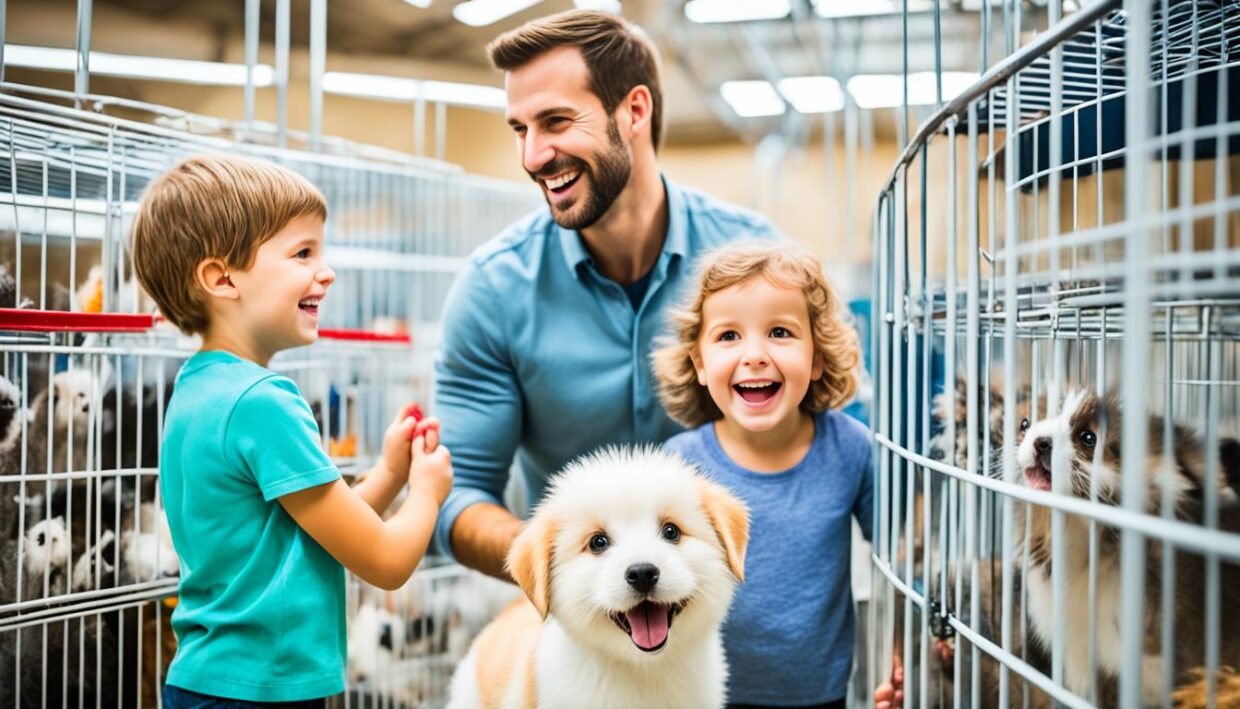
| Consideration | Details |
|---|---|
| Pet Size | Assess available space and living arrangements; larger pets need more room. |
| Energy Level | High-energy pets require more activity; consider your lifestyle and time available. |
| Breed Characteristics | Research breed traits to match with your family needs and expectations. |
| Rescue Events | Participate in pet adoption events to meet various animals and learn their histories. |
| Consultation | Seek advice from veterinarians and shelter staff to find compatible pets. |
Pet Adoption: A Lifelong Commitment
Adopting a pet is more than just bringing an animal home. It’s a lifelong commitment that requires deep understanding and careful thought. Each pet has its own needs and responsibilities. These include financial costs like vet bills and supplies.
In 2018, Americans spent $18.11 billion on vet services, a 6.1 percent increase from before. This shows how important it is to be financially ready before adopting a pet.
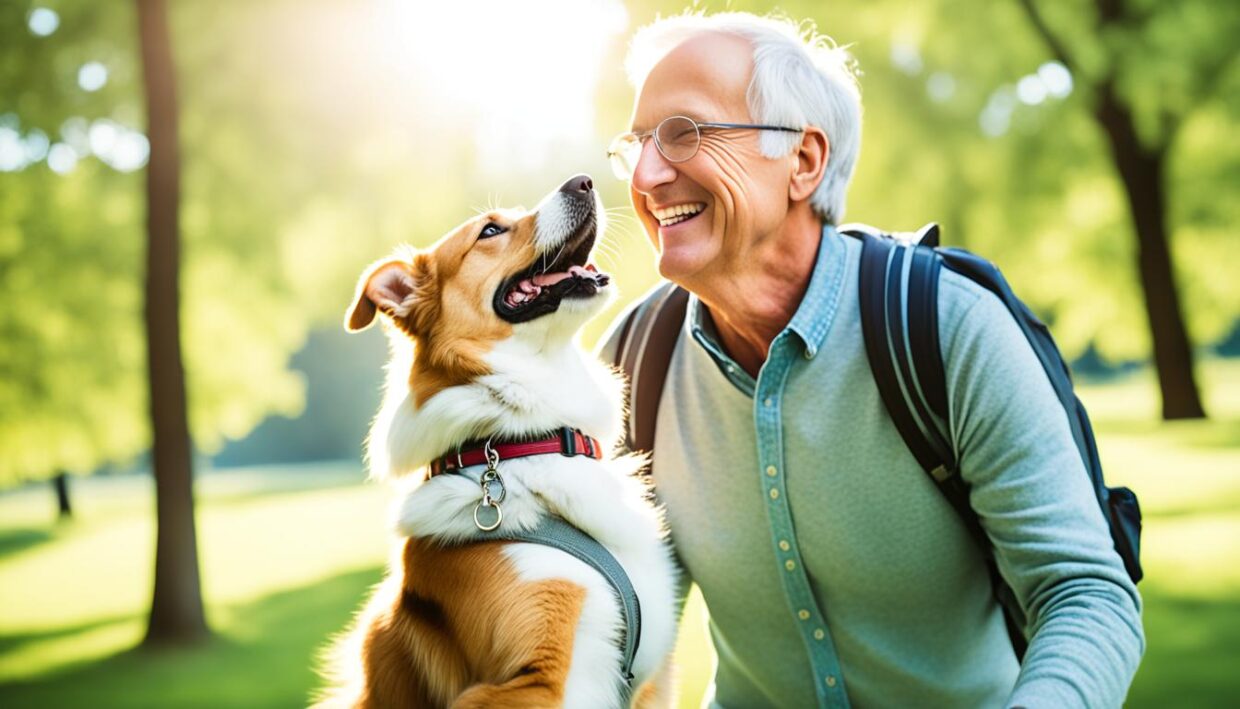
Being a pet owner means more than just paying bills. Cats can live up to 15 years or more, showing the long-term commitment of cat adoption. Owning a cat teaches responsibility and can help children learn empathy and accountability.
- Consider the cost of healthcare for your future pet.
- Research the specific needs of different breeds or species.
- Prepare financially for the long-term commitment involved.
Shelters often have too many animals, making adoptions crucial. By adopting a shelter cat, you help and set a good example for others. Cats are easy to care for, making them great for busy people. But, it’s important to know their behavior to have a good relationship.
When bringing a new cat home, introducing it to other pets is key. This helps everyone live together peacefully and builds strong bonds. Adopting a pet is a big decision that changes both your life and your pet’s for the better.
| Expense Category | 2018 Spending ($ billion) | Comments |
|---|---|---|
| Veterinary Care | 18.11 | Largest area of annual spending after food and supplies. |
| Food and Supplies | Considerable | Essential for daily care and well-being of pets. |
| Overall Pet Spending Growth | Rising | Reflects increasing commitment to pet health and welfare. |
Preparing Your Home for a New Pet
Getting your home ready for a new pet is key. It makes sure your pet settles in well and keeps them safe. Here are important steps to follow:

- Puppy-Proofing Your Space: Tape down cords, keep cleaning supplies and chemicals out of reach, and remove plants or fragile items.
- Designating a Safe Area: Create a cozy spot with a crate, bedding, and toys for your pet’s comfort and security.
- Feeding Setup: Get food and water bowls ready. Plan for three to four feedings a day to keep your puppy on a regular schedule.
Family tasks like taking the puppy out, setting up vet visits, and consistent training are crucial. Setting routines helps prevent stomach problems and bad behavior in your new pet.
When you bring a puppy home, use a crate for their safety. The first thing to do is take them to their bathroom spot to teach them. This prepares your pet for a happy life with you.
Make sure to spend time with your new pet to help them adjust. But, also give them time alone to help them feel secure and learn good behavior. It’s important to praise good behavior to avoid bad habits.
The Process of Adopting from Animal Shelters
Starting the animal shelter adoption process can feel daunting, but it’s a fulfilling journey. It ensures you and your future pet are a great match.
First, think about your lifestyle needs. Consider your living space, how much time you have, and any allergies. For example, a small apartment might suit a cat, while a family might prefer a dog or a smaller pet like a hamster.
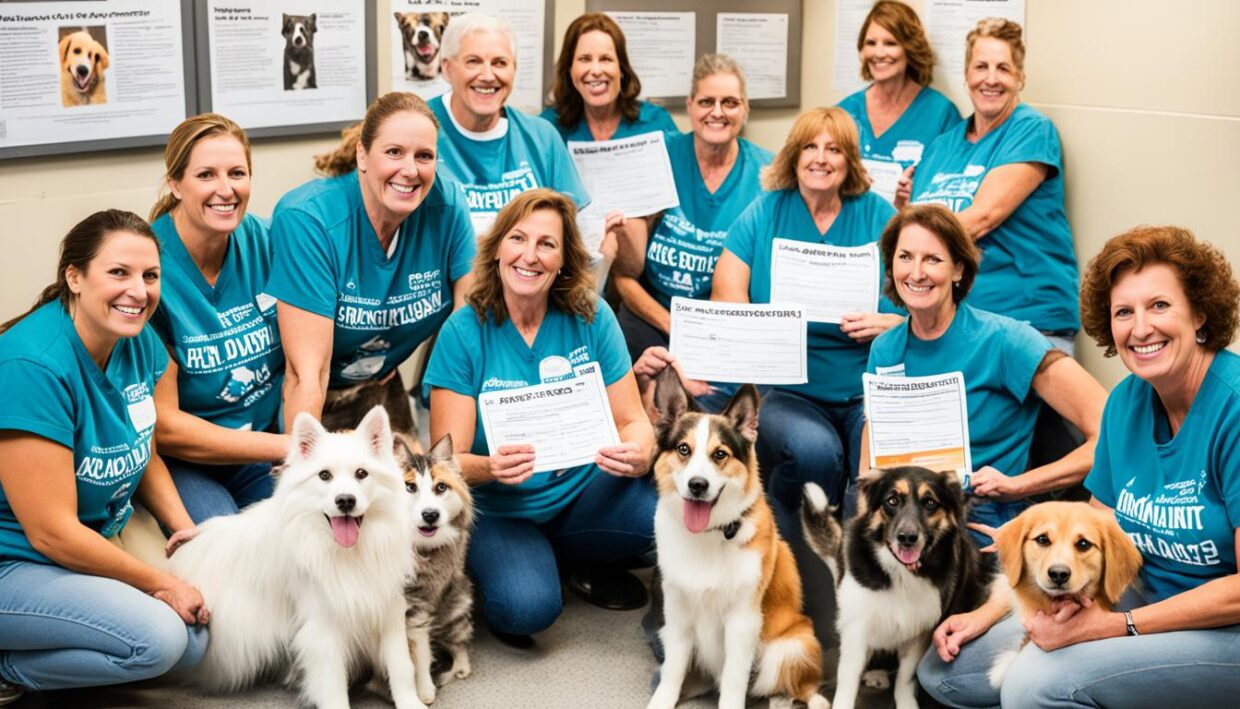
Then, visit a local animal shelter or rescue group. They have a variety of pets, including dogs, cats, birds, and fish. You’ll fill out an adoption application with your details. Then, you’ll have a shelter interview to talk about your lifestyle.
After approval, you’ll meet the pet. This is a key step to see how you connect. Watch how they act and react to you. If you choose to adopt, the pet will get medical care like spaying, neutering, microchipping, and vaccinations, all free.
Remember, pets are adopted quickly, so act fast if you find one you like. Some shelters let you hold a pet for 24 hours for a small fee. But, puppies and kittens under six months can’t be held.
By following these steps, you not only get a pet but also a loyal friend ready to be part of your life.
Adopt Don’t Shop: Why It Matters
The “adopt don’t shop” movement is all about choosing shelter pets over buying from breeders or pet stores. This choice saves lives and fights against animal overpopulation. Millions of animals need loving homes, and adopting gives them a chance for a better life.
Adopting a pet from a shelter is much cheaper than buying from a breeder or pet store. Fees range from $39 to $767 for dogs, unlike the thousands for purebreds. Shelters also cover important medical treatments, like vaccinations and sterilization, so pets are ready for their new homes.
Choosing to adopt a shelter pet shows you’re a responsible pet owner. It helps reduce the number of animals being euthanized because of overcrowding. In the U.S., about 920,000 shelter dogs and cats are euthanized each year, but this number is going down. Each adoption saves one more life.
- Many shelter animals are already trained and know basic commands, making them easier to bring home.
- Adoption helps local communities and charities that care for animals in need.
- Adopting gives a second chance to animals that may have been neglected or abused.
By adopting, you’re also fighting against puppy mills and bad breeding practices. These places put profit over animal welfare, leading to poor conditions for the animals. Choosing adoption means you’re against these practices and supporting a kinder way to own pets.
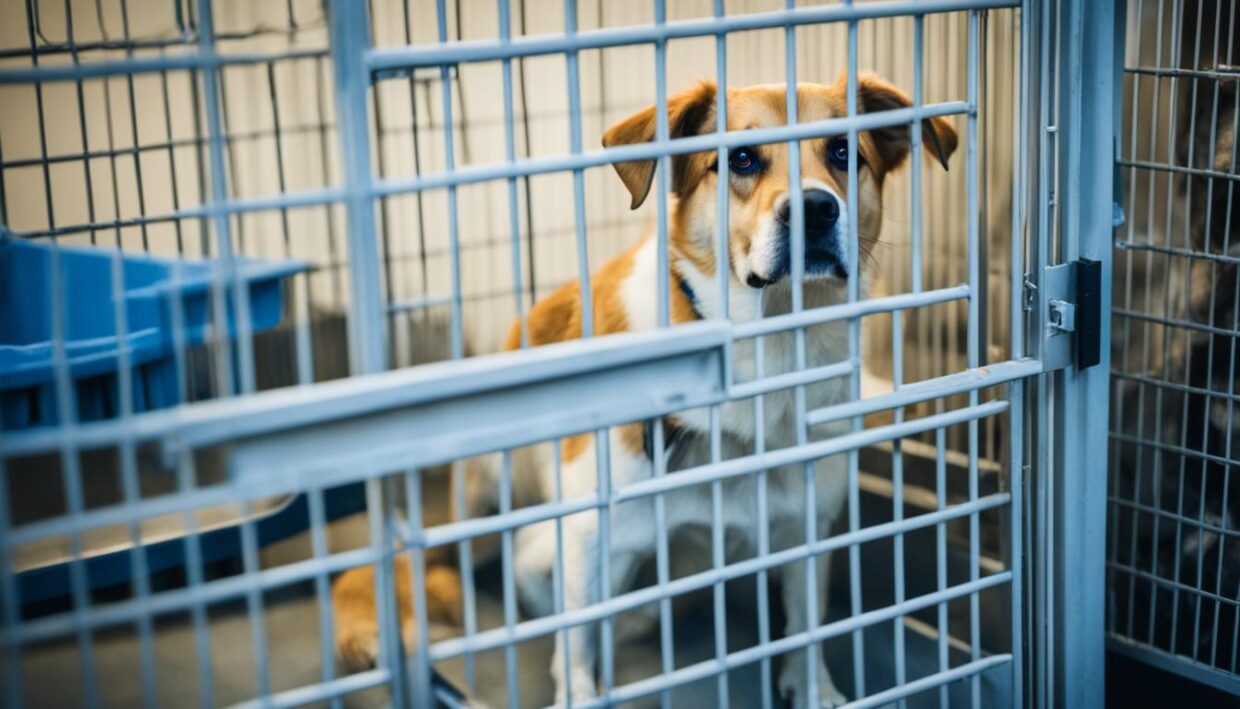
In short, adopting shelter pets is a smart choice for everyone. It brings love, companionship, and joy to both pets and people. It also helps solve the pet overpopulation problem. This choice can change lives, both human and animal.
The Role of Animal Shelters in Pet Adoption
Animal shelters are key in protecting pets and promoting responsible pet care. Every year, about 6.3 million pets find their way to shelters. These centers help by running spay and neuter programs to reduce pet overpopulation.
Many pets start their rescue journey in shelters, waiting for a new home. Shelters offer great veterinary care to improve pet health. They also teach people, kids, and adults about caring for pets and being responsible owners.
Shelters host events like pet parades to connect pets with owners and spread awareness. Even with the challenge of too many pets, shelters work hard to keep a safe place for them. This helps pets stay healthy and happy.
Shelters need donations to keep up their work. They use money and supplies to help pets. Shelters do more than just adopt pets out; they help find lost pets after disasters. Adopting a pet can lead to a lifelong friendship, making it easier for many to find a new furry friend.
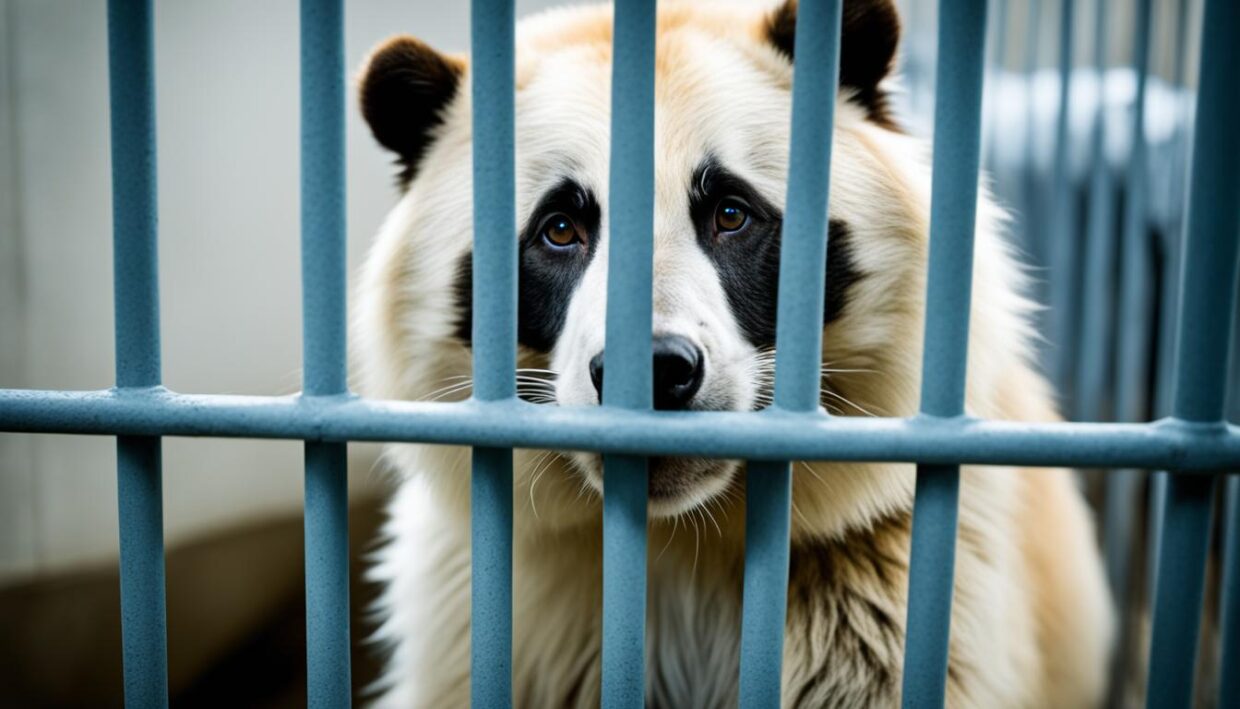
| Statistical Data | Details |
|---|---|
| Annual Entry of Pets | Approximately 6.3 million pets enter shelters nationwide. |
| Community Events | Shelters organize events like pet parades to engage the community. |
| Spay/Neuter Campaigns | Lead efforts to reduce the number of unwanted animals. |
| Veterinary Care | Provide excellent veterinary services for improved pet health. |
| Lost Pet Reunions | Assist in reuniting thousands of pets with their owners monthly. |
Understanding the Adoption Fees and What They Cover
Adoption fees are crucial for animal shelters and rescue groups. They help pay for services for pets waiting to be adopted. These services include vaccinations, spaying/neutering, and microchipping. These steps are key to responsible pet care.
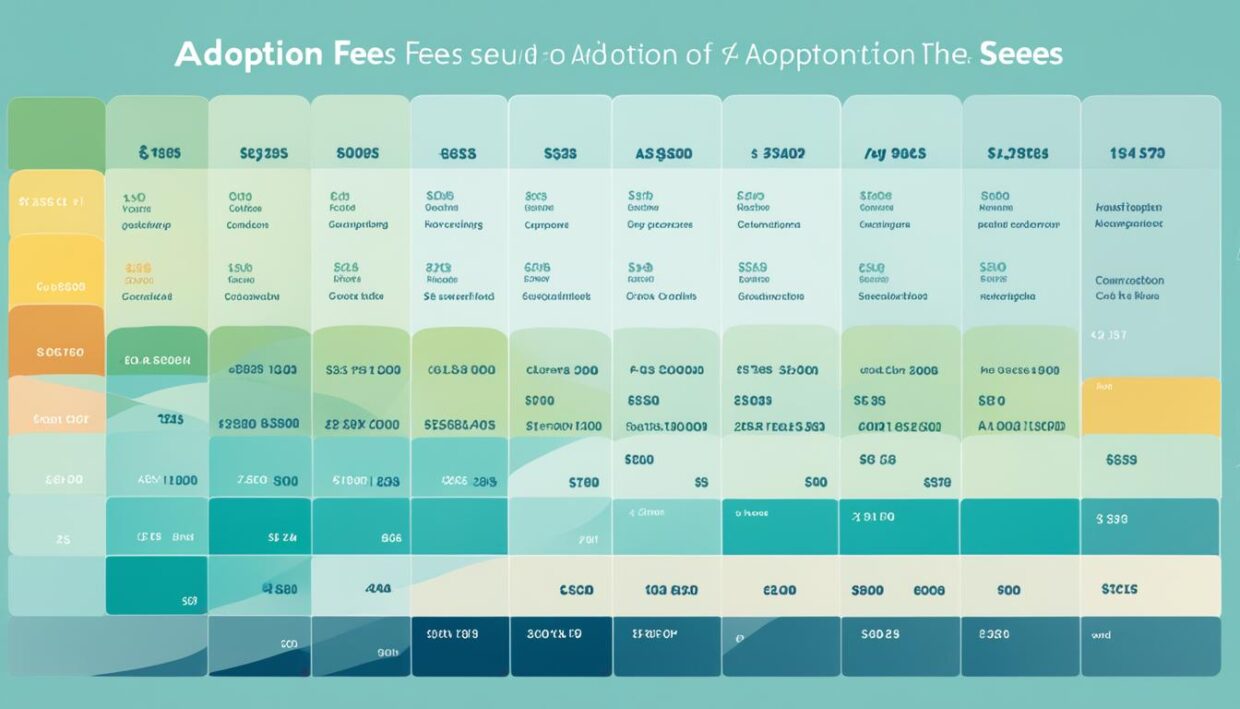
Adoption fees range from $100 to $400, depending on the pet’s age and health. Puppies and kittens cost more because they are in high demand. Senior pets have lower fees. This helps shelters balance their budgets by covering costs for pets that take longer to find homes.
It’s key for potential adopters to understand shelter costs. These fees cover more than just the pet’s price. They help pay for food, medical care, and the costs to keep the shelter running. Expenses for staff, animal transport, and foster care show the full scope of shelter costs.
Adoption fees don’t cover all shelter costs. Shelters often use fundraising and donations to make up the difference. Non-profits like One of A Kind Pet Rescue compete for grants. Adoption fees help support animals and community programs, like food aid and low-cost vaccine clinics.
Knowing what adoption fees include helps new pet owners see the value of their choice. Adopting from a shelter is cheaper than private vet care. It lets new owners give a loving home while helping animals in need.
Getting Involved with Pet Fostering Programs
Pet fostering programs are key to helping animal shelters. They rely on community members for temporary homes, easing overcrowding and improving animal care. Over 2,000 animals need foster care each year before finding a forever home. This shows how vital fostering is.
To start fostering, check the local shelter’s requirements. Volunteers must be 18 or older and live close to certain areas. The Animal Humane Society provides food, medicine, and toys to foster families. This lets foster parents focus on giving love and care.

Before fostering, know your duties. You’ll watch over the pet’s health and behavior. Volunteers work with coordinators to find the best fit for their home, whether it’s puppies or pets with health issues. Shelters pay for all medical costs, easing the financial load.
Getting ready to foster means making your home pet-friendly. Make sure it meets pet policies if you rent. Foster care can last weeks or months, preparing pets for adoption. Patience is key as shelters work hard to find each pet a home.
Pet fostering has a huge impact. It supports animal rescue and lets communities see pets transform towards adoption. Foster parents gain a lot, enriching their lives and making a big difference for animals.
| Aspect | Description |
|---|---|
| Annual Foster Care Needs | Over 2,000 animals require foster care annually at Animal Humane Society. |
| Eligibility | Foster volunteers must be 18 years or older and live within 60 miles of specific locations. |
| Support Provided | Essential supplies, medical care, and guidance from vet techs and behaviorists are provided. |
| Responsibilities | Provide water, food, a safe environment, and monitor the foster pet’s health. |
| Adoption Process | Foster parents cannot adopt their pets; interested adopters must go through official channels. |
| Training | Interested individuals must watch training sessions and understand the foster packet. |
Supporting Animal Welfare in Your Community
Supporting animal welfare in your community is crucial for improving the lives of many pets. You can help by donating or volunteering at shelters. Local charities need donations to keep running and provide vital services like vet care, food, and shelter.
Volunteering is a powerful way to help. Shelters rely on volunteers to keep things running. Even if you can’t volunteer full-time, joining community fundraising events is a great option. These events help raise money and spread the word about shelter pets needing homes.
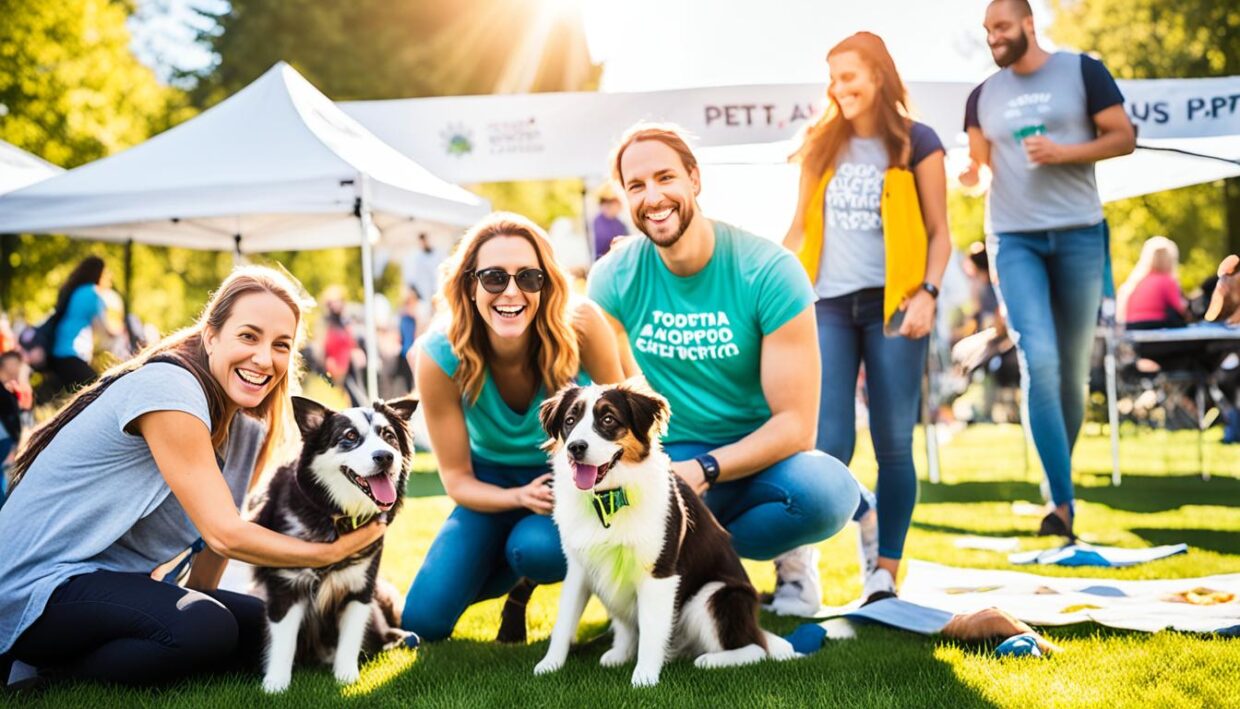
Fostering pets is another way to help. Shelters often need people to take pets into their homes temporarily. By fostering, you can make a big difference in a pet’s life and help it find a forever home. You can also donate supplies from shelters’ wish lists to help with daily needs.
Groups like the Humane Society and local shelters work together to encourage community support. They offer programs and resources for community involvement. For example, Pets for Life helps local groups by providing veterinary care and services for free to pet owners.
| Support Type | Description | Impact |
|---|---|---|
| Donations | Monetary contributions or supplies | Assists with funding shelter operations |
| Volunteering | Working directly at shelters or events | Enhances shelter operations |
| Fostering | Providing temporary homes for pets | Increases chances of pets being adopted |
| Fundraising Events | Community-driven efforts to raise funds | Supports shelter activities and awareness |
In summary, supporting animal welfare is key. By donating, volunteering, and fostering, you can make a big difference for pets waiting for homes. Together, we can build strong networks that improve animal welfare in our communities.
How to Become a Responsible Pet Owner
Being a responsible pet owner means taking care of both the pet and yourself. It’s important to follow pet care tips to help pets thrive. This care is needed from the start to the end of their lives.
When you start with the adoption process, think carefully about the commitment. Many pets go to shelters because they were bought on a whim. Adopting gives these animals a new chance at happiness, showing that it’s better than buying.
After adopting, keeping your pet healthy is key. Responsible pet care means regular vet visits for shots and parasite prevention. A routine health check helps your pet live a long, healthy life.
Training and socialization are also crucial for pets. Teaching them basic commands and socializing them helps them behave well. This makes for a better relationship between the pet and its surroundings. If your pet needs extra help, look into behavioral training to make things easier for them.
Being responsible also means being a good citizen. Make sure your pets are microchipped, wear collars with ID tags, and behave well in public. Creating a safe space shows you care about being a responsible pet owner.
The journey with your pet doesn’t stop after adoption. It takes a long-term commitment, including both emotional and financial support. Be ready for the costs, which can range from $1,300 to $3,400 for dogs and $1,000 to $2,000 for cats. Knowing these costs helps you plan better for your pet’s care.
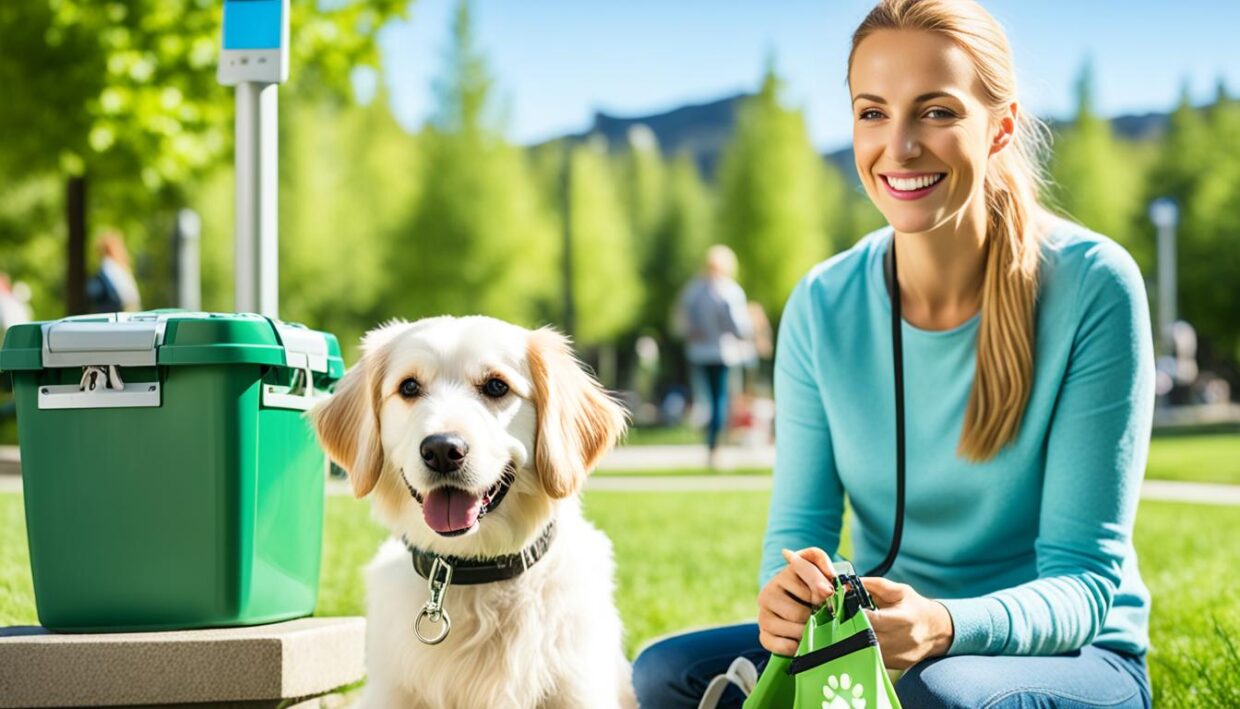
| Aspect | Description |
|---|---|
| Adoption | Consideration of commitment, preference for adopting over buying. |
| Health | Regular vet visits, vaccinations, and preventive care. |
| Training | Basic commands and socialization are crucial for well-being. |
| Social Responsibility | Microchipping, ID tags, and control in public spaces. |
| Long-term Commitment | Financial and emotional investment throughout the pet’s life. |
Following these pet care tips is key to being a responsible pet owner. It ensures pets and owners live happy lives together. By doing this, pet owners help their communities and support animal welfare everywhere.
Conclusion
The pet adoption journey is more than just finding a new friend. It’s a promise to give a loving home to a pet for life. Every year, thousands of pets end up in shelters. This shows how important it is for kind people to adopt them.
By adopting, you save a life and get a friend who brings joy and companionship. This can make your life much richer.
Adopting a pet also helps animal advocacy groups. Many shelters are non-profits that need adoption fees and donations to care for the animals. These fees pay for important services like vaccinations and spaying or neutering. So, adopting shows you value your contribution to their care.
Remember, adopting helps not just your new pet but also others in the community. It supports their health and well-being.
In conclusion, adopting a pet has many emotional and social benefits. Every animal deserves a second chance. By helping at your local animal shelter, you make a big difference in animal welfare. Adopting a pet can change both your life and the life of a deserving animal.





















Be the first to leave a comment